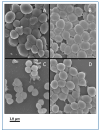Virulence Characteristics of mecA-Positive Multidrug-Resistant Clinical Coagulase-Negative Staphylococci
- PMID: 32369929
- PMCID: PMC7284987
- DOI: 10.3390/microorganisms8050659
Virulence Characteristics of mecA-Positive Multidrug-Resistant Clinical Coagulase-Negative Staphylococci
Abstract
Coagulase-negative staphylococci (CoNS) are an important group of opportunistic pathogenic microorganisms that cause infections in hospital settings and are generally resistant to many antimicrobial agents. We report on phenotypic and genotypic virulence characteristics of a select group of clinical, mecA-positive (encoding penicillin-binding protein 2a) CoNS isolates. All CoNS were resistant to two or more antimicrobials with S. epidermidis strain 214EP, showing resistance to fifteen of the sixteen antimicrobial agents tested. Aminoglycoside-resistance genes were the ones most commonly detected. The presence of megaplasmids containing both horizontal gene transfer and antimicrobial resistance genetic determinants indicates that CoNS may disseminate antibiotic resistance to other bacteria. Staphylococcus sciuri species produced six virulence enzymes, including a DNase, gelatinase, lipase, phosphatase, and protease that are suspected to degrade tissues into nutrients for bacterial growth and contribute to the pathogenicity of CoNS. The PCR assay for the detection of biofilm-associated genes found the eno (encoding laminin-binding protein) gene in all isolates. Measurement of their biofilm-forming ability and Spearman's rank correlation coefficient analyses revealed that the results of crystal violet (CV) and extracellular polymeric substances (EPS) assays were significantly correlated (ρ = 0.9153, P = 3.612e-12). The presence of virulence factors, biofilm-formation capability, extracellular enzymes, multidrug resistance, and gene transfer markers in mecA-positive CoNS clinical strains used in this study makes them powerful opportunistic pathogens. The study also warrants a careful evaluation of nosocomial infections caused by CoNS and may be useful in studying the mechanism of virulence and factors associated with their pathogenicity in vivo and developing effective strategies for mitigation.
Keywords: coagulase-negative staphylococci; multidrug-resistant; virulence.
Conflict of interest statement
The authors declare no conflict of interest.
Figures







Similar articles
-
Frequency and Characterization of Antimicrobial Resistance and Virulence Genes of Coagulase-Negative Staphylococci from Wild Birds in Spain. Detection of tst-Carrying S. sciuri Isolates.Microorganisms. 2020 Aug 29;8(9):1317. doi: 10.3390/microorganisms8091317. Microorganisms. 2020. PMID: 32872433 Free PMC article.
-
Identification of Variable Traits among the Methicillin Resistant and Sensitive Coagulase Negative Staphylococci in Milk Samples from Mastitic Cows in India.Front Microbiol. 2017 Jul 31;8:1446. doi: 10.3389/fmicb.2017.01446. eCollection 2017. Front Microbiol. 2017. PMID: 28824577 Free PMC article.
-
Biofilm formation of methicillin-resistant coagulase negative staphylococci (MR-CoNS) isolated from community and hospital environments.PLoS One. 2017 Aug 31;12(8):e0184172. doi: 10.1371/journal.pone.0184172. eCollection 2017. PLoS One. 2017. PMID: 28859149 Free PMC article.
-
Are coagulase-negative staphylococci virulent?Clin Microbiol Infect. 2019 Sep;25(9):1071-1080. doi: 10.1016/j.cmi.2018.11.012. Epub 2018 Nov 29. Clin Microbiol Infect. 2019. PMID: 30502487 Review.
-
Phenotypic characteristics of coagulase-negative staphylococci: typing and antibiotic susceptibility.APMIS Suppl. 1999;91:1-42. APMIS Suppl. 1999. PMID: 10230367 Review.
Cited by
-
Virulence and Antimicrobial Resistance in Canine Staphylococcus spp. Isolates.Microorganisms. 2021 Mar 2;9(3):515. doi: 10.3390/microorganisms9030515. Microorganisms. 2021. PMID: 33801518 Free PMC article.
-
Improved diagnostic prediction of the pathogenicity of bloodstream isolates of Staphylococcus epidermidis.PLoS One. 2021 Mar 26;16(3):e0241457. doi: 10.1371/journal.pone.0241457. eCollection 2021. PLoS One. 2021. PMID: 33770084 Free PMC article.
-
The prevalence of multidrug resistance in Staphylococcus hominis isolated from clinical materials.Sci Rep. 2025 Jan 2;15(1):414. doi: 10.1038/s41598-024-84500-2. Sci Rep. 2025. PMID: 39747570 Free PMC article.
-
Concentration-Dependent Global Quantitative Proteome Response of Staphylococcus epidermidis RP62A Biofilms to Subinhibitory Tigecycline.Cells. 2022 Nov 3;11(21):3488. doi: 10.3390/cells11213488. Cells. 2022. PMID: 36359886 Free PMC article.
-
Antibacterial activity and antibacterial mechanism of flavaspidic acid BB against Staphylococcus haemelyticus.BMC Microbiol. 2023 Sep 29;23(1):276. doi: 10.1186/s12866-023-02997-5. BMC Microbiol. 2023. PMID: 37773054 Free PMC article.
References
LinkOut - more resources
Full Text Sources

